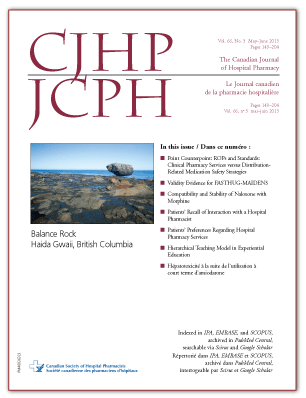Compatibility and Stability of Morphine Sulphate and Naloxone Hydrochloride in 0.9% Sodium Chloride for Injection
DOI:
https://doi.org/10.4212/cjhp.v66i3.1253Keywords:
naloxone, morphine, compatibility, compatibilitéAbstract
ABSTRACT
Background: Naloxone may be administered in conjunction with morphine to reduce the risk of opioid-induced pruritis. Combining these drugs for coadministration may be beneficial, but little is known about their physical compatibility and stability in combined solutions.
Objective: To describe the physical compatibility and stability of morphine sulphate and naloxone hydrochloride (at various concentrations) in IV admixtures.
Methods:The physical compatibility and stability of admixtures of morphine 1000 μg/mL and naloxone 4 μg/mL, 12.5 μg/mL, and 25 μg/mL in 0.9% sodium chloride were studied. For each concentration of naloxone, one bag was stored at room temperature (22°C) for 72 h and one bag was stored under refrigeration (4°C) for 30 days. For all preparations, physical characteristics, including pH, colour, and formation of precipitate, were evaluated. The samples were also analyzed by a stability-indicating high-performance liquid chromatographic method. Stability was defined as the retention of at least 90% of the initial concentration.
Results: No notable changes in pH or colour and no macroprecipitation were observed in any of the preparations after storage at 22°C for up to 72 h or at 4°C for up to 30 days. All preparations maintained more than 90% of the initial concentrations of morphine and naloxone at the end of the respective study periods. The calculated lower limit of the 95% confidence interval also indicated that 90% or more of the initial concentration remained at the end of each study period.
Conclusion: Admixtures of morphine sulphate and naloxone hydrochloride were stable for 72 h at room temperature and for 30 days with refrigeration.
RÉSUMÉ
Contexte : La naloxone peut être administrée en concomitance avec la morphine pour réduire le risque de prurit induit par les opioïdes. L’association de ces médicaments pour leur administration concomitante peut être bénéfique, mais on ne sait que peu de choses sur leur compatibilité physique et leur stabilité dans des solutions combinées.
Objectif : Décrire la compatibilité physique et la stabilité du sulfate de morphine et du chlorhydrate de naloxone (à diverses concentrations) mélangés dans des solutions pour administration i.v.
Méthodes : La compatibilité physique et la stabilité des mélanges de morphine à 1000 μg/mL et de naloxone à 4 μg/mL, 12,5 μg/mL et 25 μg/mL dans du chlorure de sodium à 0,9 % ont été étudiées. Pour chaque concentration de naloxone, on a entreposé un sac à la température ambiante (22 °C) pendant 72 heures et un autre au réfrigérateur (4 °C) pendant 30 jours. Les propriétés physiques, notamment le pH, la couleur et la formation de précipité, ont été évaluées pour toutes les préparations. Les échantillons ont aussi été analysés à l’aide d’une épreuve validée mesurant la stabilité par chromatographie liquide haute performance. La stabilité a été définie comme étant la rétention d’au moins 90 % de la concentration initiale des agents.
Résultats : Aucun changement notable du pH ou de la couleur et aucune formation de macroprécipité n’ont été observés dans l’ensemble des préparations qui ont été conservées à une température de 22 °C pendant un maximum de 72 heures ou à une température de 4 °C pendant un maximum de 30 jours. Toutes les préparations ont conservé plus de 90 % de leurs concentrations initiales de morphine et de naloxone à la fin de leurs périodes d’étude respectives. La limite inférieure de l’intervalle de confiance à 95 % indiquait également que 90 % ou plus de la concentration initiale subsistait à la fin de chaque période d’étude.
Conclusion: Les mélanges de sulfate de morphine et de chlorhydrate de naloxone sont demeurés stables pendant 72 heures à la température ambiante et pendant 30 jours lorsqu’ils étaient réfrigérés.
Downloads
Published
Issue
Section
License
Copyright © Canadian Society of Healthcare-Systems Pharmacy.
After publication of a manuscript in the CJHP, the authors of the manuscript must obtain written permission from the CSHP (publications@cshp.ca) before reproducing any text, figures, tables, or illustrations from the work in future works of their own. If a submitted manuscript is declined for publication in the CJHP, all said rights shall revert to the authors. Please note that any forms (e.g., preprinted orders and patient intake forms) used by a specific hospital or other health care facility and included as illustrative material with a manuscript are exempt from this copyright transfer. The CJHP will require a letter from the hospital or health care facility granting permission to publish the document(s).










